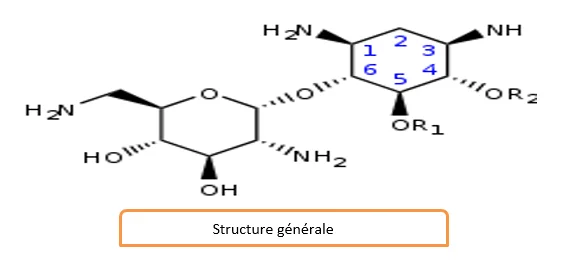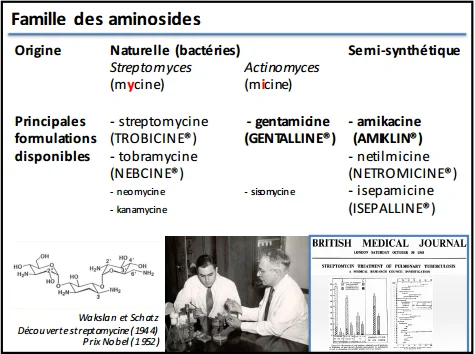Aminoglycosides are water-soluble cationic antibiotics., very stable, with a broad spectrum and endowed with a rapid bactericidal activity.
They are natural or semi-synthetic products, used in severe infections, but not widely used because they have severe toxicity.
These antibiotics act by inhibiting protein synthesis and are often used in combination with other antibiotics.
◉ Structure of Aminoglycosides

A distinction is made between natural and semi-synthetic ancient aminoglycosides: :

◉ Mechanism of action of aminoglycosides
Penetration into a bacterium takes place in three stages :
Are active, require proton motive force and respiratory chain enzymes and electron translocating ATPase.◉ The first
Penetration through the peptidoglycan is passive, rapid and nonspecific in Gram+ and the outer membrane then (GN) (Water-soluble and charged +pass through porins of the outer membrane of GN by disorganizing the double lipid layer)
◉ The second and third (EDP (Energy dependent phase) 1 and 2)
Are active, require proton motive force and respiratory chain enzymes and electron translocating ATPase.
EDP1 :
Rapid and massive is characterized by saturation of ribosomal sites. This step is essential for bactericidal activity and is only observed in sensitive strains.
This active penetration mechanism explains why bacteria lacking respiratory chain enzymes are not or only slightly sensitive to aminoglycosides: strict anaerobes (Clostridium) or oxygen-tolerant anaerobes (streptococci, pneumococci and enterococci).
Aminoglycosides are inhibitors of protein synthesis which exert pleiotropic effects on the bacterium, they inhibit translation at the stages of initiation, elongation, and termination.
In addition, they interfere with the electron transport systems of the respiratory chain, cause ionic disorders, alter bacterial envelopes and indirectly affect DNA replication.
Their target is the 16S RNA of the bacterial ribosome.
The A site is the seat of attachment of the 4,6-2-DOS, this site constitutes a pocket where the transfer RNAs are positioned during codon-anticodon recognition, the bases of the A site which establish links with the aminoglycosides play a role. essential role in the activity of the ATBs, this fixation stabilizes the aspecific pairings normally eliminated by a proofreading activity and consequently generates translation errors.
Very powerful bactericide, very fast in less than 4 hours without inoculum effect, hence their advantage in the first days of TRT plus post ATB effect.
◉ Activity spectrum of aminoglycosides
◉ Broad spectrum that varies little from one product to another
- Gram-positive cocci: staphylococcus although resistant
- Gram-negative cocci: gonococcus, not very active on meningococcus
- Gram-positive bacillus: Listeria, Corynebacterium diphtherium, Bacillus anthracis
- Gram-negative bacilli (Enterobacteriaceae, Pseudomonas, Acinetobacter)
- Active on Koch's bacillus (especially kanamycin and streptomycin)
- Haut niveau pour anaérobies strictes
- Low level for aerotolerant anaerobes (Streptococcus, Pneumococcus and Enterococcus).
Plazomicin : new generation
It is a semi-synthetic antibiotic derived from sisomicin. It is protected from the activity of aminoglycoside modifying enzymes.
It is active on MDR and ESBL enterobacteria and resistant to colistin and active on MRSA and pseudomonas.
Indicated in complicated urinary tract infections (kidney infection ).